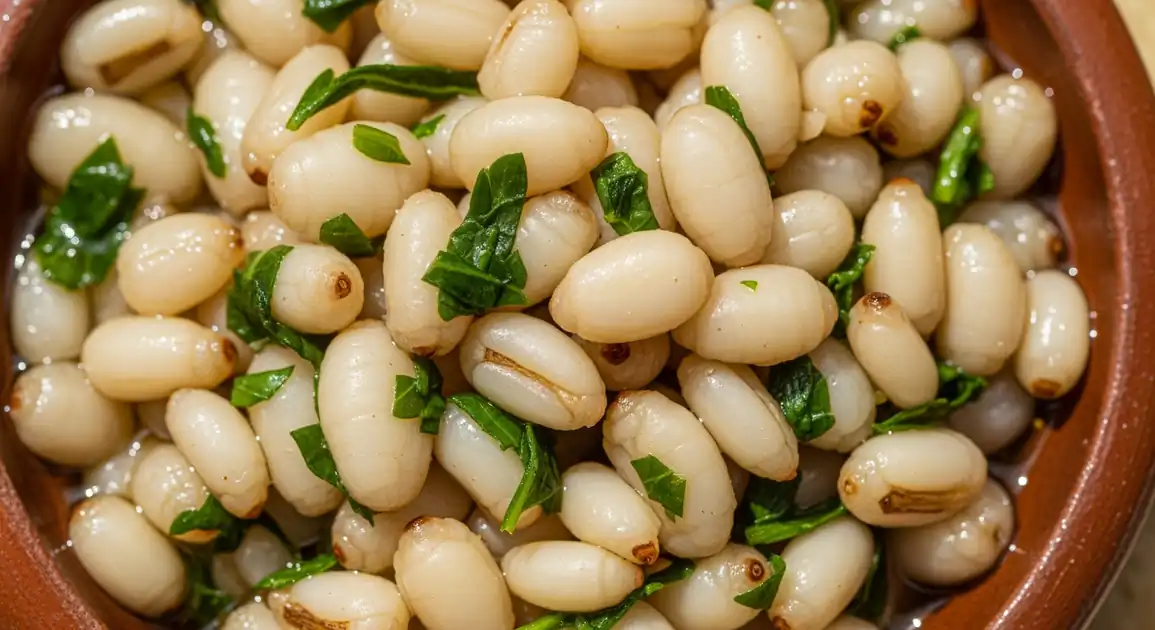Escamoles (Ant Larvae/Pupae)
Escamoles

Description
Escamoles are a traditional delicacy primarily found in the high-altitude regions of Central Mexico, including states like Hidalgo, Tlaxcala, Puebla, and the State of Mexico. Their availability is concentrated in restaurants and markets specializing in regional or pre-Hispanic cuisine, strictly during the spring harvest season (approx. Feb-May).
Dietary Information
Serving information
Serving style
Served hot, typically in a small bowl ('cazuela') or on a plate, often accompanied by warm corn tortillas for making tacos. Eaten with a fork or spooned into tortillas.
Quick facts
Restaurant hours (Lunch/Dinner) during Spring season. Market availability typically mornings.
Safety Tips
What to Look For
-
Served in a reputable restaurant known for handling seasonal/pre-Hispanic ingredients
Ensures better sourcing, handling, and freshness knowledge for this perishable delicacy.
-
Creamy white, plump appearance (cooked)
Fresh, properly cooked escamoles should look moist and have a pale, appealing color. Avoid grey or discolored ones.
-
Dish is served hot and smells fresh/nutty
Temperature indicates recent preparation. Off-smells are a clear warning sign of spoilage.
-
Clear information about seasonality (ordering during Spring: Feb-May)
Authentic, fresh escamoles are primarily available during this window. Off-season offerings are likely frozen or preserved, affecting quality.
What to avoid
-
Suspiciously cheap escamoles
Harvesting is difficult, making them expensive. Very low prices might indicate poor quality, spoilage, or adulteration.
-
Escamoles served lukewarm or cold
Indicates they were not freshly prepared, increasing spoilage risk.
-
Dull, grey, brownish, or dried-out appearance
Strong indicators of poor quality or spoilage.
-
Vendors or restaurants with questionable hygiene standards
General cleanliness is crucial, especially for delicate ingredients.
-
Ordering if you have a known shellfish or insect allergy without caution
Potential for cross-reactivity exists. Consult with staff or start with a minimal portion.
Price information
Price range
Budget tips
- Prices are per portion (typically appetizer size, 100-150g).
- Expect higher prices in upscale restaurants in major cities like Mexico City.
- Market prices (for raw or simply cooked) might be slightly lower but require careful quality assessment.
- Considered a luxury item, not a budget snack.
Value indicators
- Creamy white color and plump texture.
- Fresh, nutty aroma.
- Served in a restaurant known for quality ingredients.
- Clear indication of seasonal availability.
Where to Find This Dish
High-End Restaurant Zones
Found in districts known for fine dining and traditional Mexican cuisine in cities like Mexico City, Puebla, Tlaxcala.
Polanco (Mexico City), Centro Histórico (various cities)
Lunch, Dinner (during season)
Specialty Markets
Markets famous for exotic ingredients, like Mercado de San Juan in Mexico City, may sell them raw or cooked during season.
Mercado de San Juan (Mexico City)
Morning/Mid-day (during season)
Vendor Tips
- Always confirm freshness and seasonal availability before ordering.
- Ask how they are prepared; 'con mantequilla y epazote' is classic.
- Trust reputable restaurants over unknown vendors, especially for your first time.
How to Order
Regional Variations
-
Escamoles al Mojo de Ajo
(Escamoles al Mojo de Ajo)
Sautéed with abundant garlic and butter or oil.
-
Escamoles con Mantequilla y Epazote
(Escamoles con Mantequilla y Epazote)
The most classic preparation: sautéed simply with butter and the herb epazote.
-
Tacos de Escamoles
(Tacos de Escamoles)
Sautéed escamoles served inside warm corn tortillas, often with a simple salsa or guacamole.
-
Escamoles en Omelet
(Omelet con Escamoles)
Cooked escamoles folded into an egg omelet.
-
Escamoles con Guacamole
(Escamoles con Guacamole)
Served alongside or mixed into fresh guacamole.
Cultural context
History
Consumed since pre-Hispanic times, escamoles were a valuable source of protein for Aztec and other indigenous cultures in Mesoamerica. Their collection, often from the base of maguey or nopal plants, was and remains a labor-intensive process. Today, they are considered a gourmet ingredient, connecting modern Mexican cuisine with its ancient roots.
Local significance
A highly valued pre-Hispanic food, representing a deep connection to Mexico's culinary heritage and biodiversity. Considered a gourmet delicacy.
Eating customs
- Often shared as a special appetizer.
- Making small tacos with corn tortillas is the most common way to eat them.
- Savor the unique texture and delicate flavor.